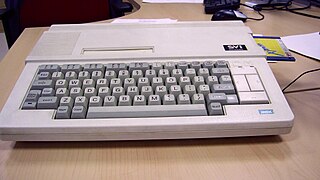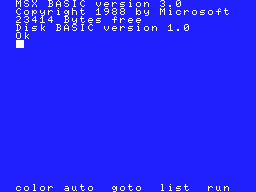
The Amstrad CPC is a series of 8-bit home computers produced by Amstrad between 1984 and 1990. It was designed to compete in the mid-1980s home computer market dominated by the Commodore 64 and the ZX Spectrum, where it successfully established itself primarily in the United Kingdom, France, Spain, and the German-speaking parts of Europe.

The RadioShack TRS-80 Color Computer, later marketed as the Tandy Color Computer, is a series of home computers developed and sold by Tandy Corporation. Despite sharing a name with the earlier TRS-80, the Color Computer is a completely different system and a radical departure in design based on the Motorola 6809E processor rather than the Zilog Z80 of earlier models.

The Atari 8-bit computers, formally launched as the Atari Home Computer System, are a series of 8-bit home computers introduced by Atari, Inc. in 1979 with the Atari 400 and Atari 800. It is the first home computer architecture with coprocessors, enabling more advanced graphics and sound than most of its contemporaries. Video games are key to its software library, and the 1980 first-person space combat simulator Star Raiders is considered the platform's killer app.

The Bally Astrocade is a second-generation home video game console and simple computer system designed by a team at Midway, at that time the videogame division of Bally. It was originally announced as the "Bally Home Library Computer" in October 1977 and initially made available for mail order in December 1977. But due to production delays, the units were first released to stores in April 1978 and its branding changed to "Bally Professional Arcade". It was marketed only for a limited time before Bally decided to exit the market. The rights were later picked up by a third-party company, who re-released it and sold it until around 1984. The Astrocade is particularly notable for its very powerful graphics capabilities for the time of release, and for the difficulty in accessing those capabilities.

MSX is a standardized home computer architecture, announced by ASCII Corporation on June 16, 1983. It was initially conceived by Microsoft as a product for the Eastern sector, and jointly marketed by Kazuhiko Nishi, the director at ASCII Corporation. Microsoft and Nishi conceived the project as an attempt to create unified standards among various home computing system manufacturers of the period, in the same fashion as the VHS standard for home video tape machines. The first MSX computer sold to the public was a Mitsubishi ML-8000, released on October 21, 1983, thus marking its official release date.

The TMS9918 is a video display controller (VDC) manufactured by Texas Instruments, in manuals referenced as "Video Display Processor" (VDP) and introduced in 1979. The TMS9918 and its variants were used in the ColecoVision, CreatiVision, Memotech MTX, MSX, NABU Personal Computer, SG-1000/SC-3000, Spectravideo SV-318, SV-328, Sord M5, Tatung Einstein, TI-99/4, Casio PV-2000, Coleco Adam, Hanimex Pencil II, and Tomy Tutor.

The Yamaha V9958 is a Video Display Processor used in the MSX2+ and MSX turbo R series of home computers, as the successor to the Yamaha V9938 used in the MSX2. The main new features are three graphical YJK modes with up to 19268 colors and horizontal scrolling registers. The V9958 was not as widely adopted as the V9938.

The Yamaha V9938 is a video display processor (VDP) used on the MSX2 home computer, as well as on the Geneve 9640 enhanced TI-99/4A clone and the Tatung Einstein 256. It was also used in a few MSX1 computers, in a configuration with 16kB VRAM.

The ATM Turbo, also known simply as ATM is a ZX Spectrum clone, developed in Moscow in 1991, by two firms, MicroArt and ATM.
MSX-DOS is a discontinued disk operating system developed by Microsoft's Japan subsidiary for the 8-bit home computer standard MSX, and is a cross between MS-DOS v1.25 and CP/M-80 v2.2.
The Geneve 9640 is an enhanced TI-99/4A clone. It was sold by the company Myarc as a card to fit into the Texas Instruments TI Peripheral Expansion System. Released in 1987, it is in many ways similar to the earlier TI-99/8, which was in prototype form in early 1983. The Geneve 9640 was designed by Paul Charlton, and the graphical swan on the boot up screen was designed by Mi-Kyung Kim.

The Spectravideo SVI-738 X'Press is an MSX1 compatible home computer manufactured by Spectravideo from 1985. Although compatible with the MSX 1.0 standard, it incorporates several extensions to the standard ; many are hardware-compatible with the MSX 2.0 standard but the system as a whole is not, leading to it being referred to as an "MSX 1.5" computer.

NMS-8250, was a professional MSX2 home computer for the high end market, with two built in floppy disk drives in a "pizza box" configuration, released in 1986. The machine was in fact manufactured by Sanyo and it is basically the MPC-25FS with a different color.

Toshiba Pasopia 7 is a computer from manufacturer Toshiba, released in 1983 and only available in Japan, with a price of $1350.

The Panasonic FS-A1WSX released in 1989 was the last MSX2+ made by Panasonic. It was the successor of FS-A1WX and incorporated few changes like S-Video output, no tape support, color printer support and an improved A1 Internal Cockpit software with a Kanji color word processor.
The HB-F9P was a Sony MSX2-computer, launched in 1985. The abbreviation HB stands for Hit Bit.
The IBM Personal Computer Basic, commonly shortened to IBM BASIC, is a programming language first released by IBM with the IBM Personal Computer, Model 5150 in 1981. IBM released four different versions of the Microsoft BASIC interpreter, licensed from Microsoft for the PC and PCjr. They are known as Cassette BASIC, Disk BASIC, Advanced BASIC (BASICA), and Cartridge BASIC. Versions of Disk BASIC and Advanced BASIC were included with IBM PC DOS up to PC DOS 4. In addition to the features of an ANSI standard BASIC, the IBM versions offered support for the graphics and sound hardware of the IBM PC line. Source code could be entered with a full-screen editor, and limited facilities were provided for rudimentary program debugging. IBM also released a version of the Microsoft BASIC compiler for the PC concurrently with the release of PC DOS 1.10 in 1982.
The TC 3256 or Timex Computer 3256 was a 1987 computer created by Timex of Portugal, a branch of Timex Corporation.













